|

 Up
Up 
 Stalled in
Stalled in
Europe 
(You are here.)
 Down
Down




  Need
to Need
to
find your
bearings?
Try
these
navigation aids:
If
this is your first
visit, please stop by:
Something
to share?
Please:



|
|
Available in Française, Español, Português, Deutsch, Россию,
中文,
日本, and others.
 n
late 1906, the Wrights seemed to make some progress in selling their
airplane. Charles Flint, a highly successful New York dealmaker, heard of
their invention through a former employee. He invited them to meet with
him when they visited New York in December to attend the Aero Club of
America exhibition. They met, and Flint explained he would like to sell
the Wright airplane abroad, especially in Europe. After several follow-up
meetings in both New York and Dayton, Flint and the Wrights arrived at a
tentative agreement. Flint fired up his sales force in Britain, France,
and Germany. n
late 1906, the Wrights seemed to make some progress in selling their
airplane. Charles Flint, a highly successful New York dealmaker, heard of
their invention through a former employee. He invited them to meet with
him when they visited New York in December to attend the Aero Club of
America exhibition. They met, and Flint explained he would like to sell
the Wright airplane abroad, especially in Europe. After several follow-up
meetings in both New York and Dayton, Flint and the Wrights arrived at a
tentative agreement. Flint fired up his sales force in Britain, France,
and Germany.
Meanwhile, the Aero Club president, Courtland Bishop, mentioned the
Wright's invention and their problems with the U.S. government to his
brother-in-law, Congressman Herbert Parsons. Parsons took the matter to
President Theodore Roosevelt. Roosevelt recommended to Secretary of War
Howard Taft that he investigate the Wright's invention. Taft sent a
directive to the Board of Ordinance, and the Secretary of the Board wrote
the Wrights requesting more information. Orville sent the information
promptly and on May 22, 1907, the secretary invited the Wrights to submit
a proposal to provide an aircraft and flight instruction to the United
States Army. Encouraged, the Wrights prepared a proposal and began to
build several aircraft with two seats, a powerful new motor, and improved
controls that they would use for demonstration flights. The Board of
Ordinance, unfortunately, did not respond with the same enthusiasm.
Although the door had been opened for the Wrights, talks dragged on.
At the same time, Flint's agent in Europe, Hart O. Berg, requested that
one of the Wright brothers travel to Europe to meet with potential buyers.
Wilbur met him in London in late May, and Berg explained that at present,
neither Great Britain nor Germany were interested in purchasing flying
machines from two American bicycle makers. The situation in France,
however, was more promising. The French were familiar with the Wright's
work, and Berg had opened talks to form a syndicate to manufacture Wright
airplanes in France. But the project soon bogged down in politics.
Slow mails, cryptic telegrams, and newspaper gossip made Orville tense
and nervous. What was happening Europe? He resolved to go, as soon as he
finished one new aircraft. In mid-July, he crated up the new airplane —
the first Wright Model A — and he and the aircraft left for France.
Charley Taylor went too, to help Orville put the aircraft together and to
serve as the Wright's flight mechanic while they were in Europe.
It wasn't to be. Once Orville was reunited with Wilbur in Europe, he
could see for himself how hopelessly ensnared their business plans had
become in bureaucracy and political intrigue. The situation brightened
briefly in Germany — they actually made some headway in forming a German
syndicate — but the negotiations stalled, as they had in France. The
brothers concluded that to sell airplanes in Europe, they would have to
make demonstration flights and peddle them to anyone who had cash in hand.
To do that, they would need a stock of airplanes. They decided to go back
to Dayton, finish the planes they had begun, and come back to Europe to
fly in the spring. On November 11, Orville and Charley Taylor left for
home. Wilbur stayed a few more weeks to tie up loose ends and to line up
some suppliers of materials they would need, then he too sailed for
Dayton.
Despite the fact that they hadn't sold an airplane or established an
airplane business, the Wrights' visit to Europe had an important effect.
While in France, they met and became friends with Lieutenant Frank Lahm,
who had recently been asked to join the new Aeronautical Division of the
United States Army Signal Corps. Lahm wrote a letter to his commander,
Brigadier General James Allen stating that it was "…unfortunate
that this American invention, which unquestionably has military value,
should not first be acquired by the United States Army." The letter
had the desired effect. It moved the Army to put pressure on the Board of
Ordinance to hurry things along. They sent a letter to the Wrights in
Europe requesting a meeting. When Wilbur docked, he caught a train for
Washington, D.C.
In Their Own Words
- Meeting Mr. Wright
– Hart O. Berg's first impressions of Wilbur
Wright.
- Selling the Wright
Aeroplane –
Charles R. Flint, a major international dealmaker and financier at the
turn of the twentieth century, remembers his dealings with the Wright
brothers and how he eventually sold their airplane to France and
Germany.
|
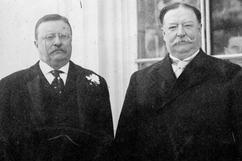
President Theodore Roosevelt and his Secretary of War, William
Howard Taft. Taft would later become president and see the U.S. Army
finally buy their first airplane from the Wright brothers..
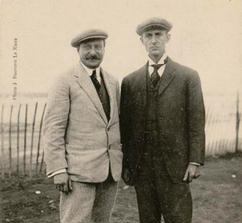
Hart O. Berg with Wilbur Wright. Berg was known in Europe as a
wheeler-dealer in new technology.
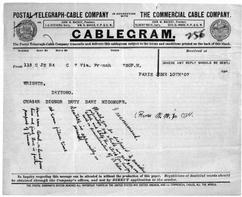
One of the many coded cables that Wilbur sent to Orville before
Orville came to Europe. Orv's translation is below the code.
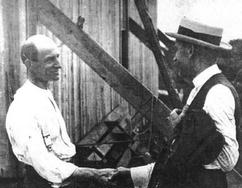
Wilbur great Charley Taylor when he arrives in France, ostensibly to
help them put an aircraft together.
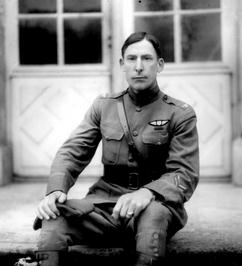
Lt. Frank Purdy Lahm was an accomplished balloonist before he joined
the Aeronautical Division, U.S. Signal Corps. |